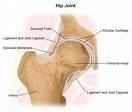As an interventional pain physician, I have the opportunity to evaluate patients who are seeking alternatives to arthroscopic hip, hip resurfacing surgery and total hip replacement surgery. Most patients want to avoid having the top of the femur sawed off and replaced with a metal prosthesis.
Most patients come with x-rays and a history of pain. Unfortunatley X-rays only visualize bone structures and as such can demonstrate fractures, tumors , degenerative changes in the bone and reduction in joint spaces between bone.
The hip is a complex structure with multiple sources of pain generators which include but are not limited to ligaments, bursa, cartilage and capsule. None of these structures can be identified on x-ray and therefore x-rays tells only part of the picture.

At the Centeno-Schultz Clinic, I reviewed the hip x-rays of a patient who had been advised that her only option to reduce her hip pain and impaired function was total hip replacement. She opted for a second opinion. Her x-ray was significant for degenerative changes in the hip socket as well as the ball of the femur. What was curious was the presence of cysts within the bone. This abnormality along with her history prompted me to order an MRI.
It demonstrated areas of decay in the bone. The disease is called avascular necrosis(AVN). 
The diagnosis was not advanced osteoarhritis of the hip. Digging deeper revealed a much more serious condition called AVN. The good news is that Regenexxutilizing autologous stem cells can stop the progression of this diease if caught early.
